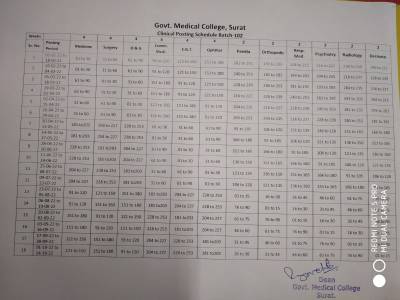Time Table
Third MBBS Phase-I Time Table Year 22-23
third_mbbs_phase_1_clinical_rotation.xlsx
| Second MBBS Annual timetable for admission batch 2020-21 |
| second_mbbs_timetable_for_admission_baqtch_2020-2021_gmc_surat.pdf |
Academics
Undergraduate courses: Prospective students for an undergraduate course leading towards a Bachelor of Medicine and Bachelor of Surgery (MBBS) degree must have completed a HSC (10+2, or high school) with the Science stream, including the subjects Biology, Chemistry and Physics with at least 50% marks.
The MBBS course starts with the basic pre-clinical subjects such as biochemistry, physiology,anatomy, microbiology, pathology and pharmacology. The students simultaneously obtain hands-on training in the wards and out-patient departments, where they interact with real patients. The curriculum aims to inculcate good habits of history taking and examination. The student is taught to arrive at a differential diagnosis and to determine what investigations will be useful in a particular case.
I (First) MBBS:
The pre-clinical course consists of Anatomy, Physiology and Biochemistry,and these are the basic subjects of medical students and it lasts for a year. Prior to 1997 the I MBBS consisted of 11⁄2 years, but this was trimmed to make more time available for clinical exposure. Passing the I MBBS final examination is mandatory to proceed with the course. A candidate failing the first MBBS examination is detained until all the 1st MBBS objects are cleared. This is considered a major drawback of the Indian medical education system.In many universities if one does not clear a subject that student will get into an intermediate batch. It is a severe drawback. Morning session usually consist of an Anatomy lecture followed by dissection, except for one day when a class in biostatistics may be taken. Afternoon sessions consist of a theory class followed by laboratory work in Physiology or Biochemistry or it may be histology branch of anatomy.
II (Second) MBBS:
Pathology, Pharmacology, Microbiology, and Forensic Medicine for one and half years. After clearing all the 4 subjects a student advances to III MBBS. The lecture classes and lab work of these subjects are usually held in the afternoons to enable students to attend the clinical wards and out patient departments in the mornings. These are followed by Short postings (15days duration) in Pediatrics, Psychiatry, Forensic medicine, Skin & Leprosy,& Respiratory medicine & TB. This may be followed directly by major postings or a clinical posting in Community Medicine may intervene.
III (Final) MBBS - Part I:
Part I consists of one year, where Social and Preventive Medicine (Community Medicine), Ear Nose and Throat and Ophthalmology form the core subjects.
III (Final) MBBS - Part II:
One year of focused training in the four basic clinical subjects, namely: Medicine, Surgery (incl. Orthopaedics), Paediatrics, Obstetrics & Gynaecology. On passing the final MBBS examination,a candidate is awarded provisional registration by the MCI or the State medical council and can start the internship. Permanent registration (license to practice) and the final Medical degree (i.e., MBBS) is given only after successful and satisfactory completion of the Compulsory Rotatory Resident Internship, also called the CRRI.
Internship:
After successful completion of the MBBS course, one has to compulsorily work in the hospital attached to the medical college or in any other approved hospital allowed in some medical colleges, for a period of one year. This posting is called the Compulsory Rotatory Residential Internship or the House Surgeon in Tamil Nadu. The student gets the degree only after satisfactory completion of the CRRI. An Intern (also called an Internee or a CRRI) is posted in all the clinical departments of the hospital on a rotation basis. This gives him the basic clinical and practical knowledge about all the disciplines of medicine and makes the medical graduate fit to work in the community as a General Physician.The schedules of an intern is usually extremely exhaustive. For example one may have to work for whole night and then again start the next day duty only after 1 to 2 hour which would last till afternoon.24 hour sleepless duty at a stretch is not uncommon and sometimes the scheduled breaks are also not allowed by the superiors. He/she is also paid a monthly stipend for his work in the hospital which differs in different medical colleges on the basis of the management. The person is licenced to practice medicine only after completion of this internship. And only after finishing internship, one can receive his MBBS degree and can pursue postgraduate studies.
The Internship is different from House Officership (which may follow Internship), as understood in UK and other countries. The latter is not a compulsory tenure. The House Physician or House Surgeon unlike an Intern, works in a particular department of his or her choice and is paid a monthly 'salary' for his work in the hospital (especially, in the UK). The American counterpart is simply called a “Resident” (i.e., a Resident Physician or a Resident Surgeon).But in India nevertheless, the Internship or the House Surgeoncy or the House Officership - all are considered to be one-&-the-same. Besides, there is no such term as a “House Physician”. This is because, in India, the Doctor who is undergoing higher specialty training following Internship is called a “Post-Graduate student” (i.e., a Medicine PG student or a Surgery PG student).
Responsibility of an intern:
The Interns are entrusted with clinical responsibilities under the supervision of a Medical teacher or a Resident/ PG student/ Senior medical officer. They do not work independently. Interns are not supposed to issue medical certificates, death certificates or medico-legal documents under their own signatures.
Postgreaduation induction for all residents about laboratory services
